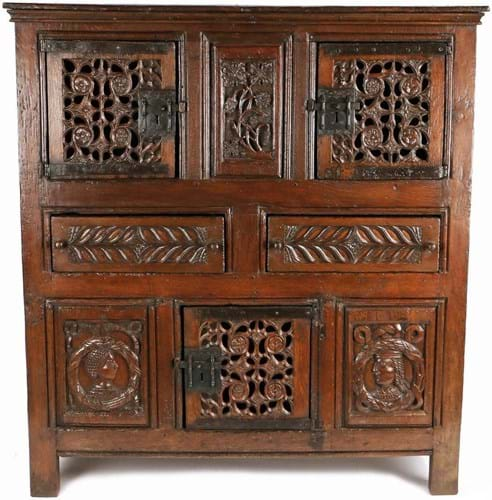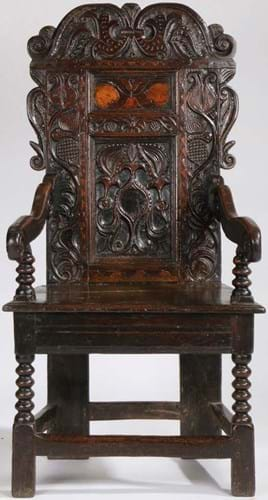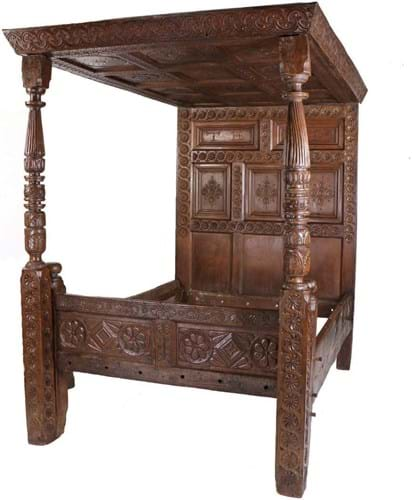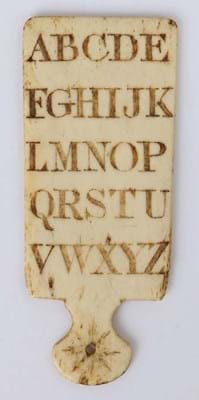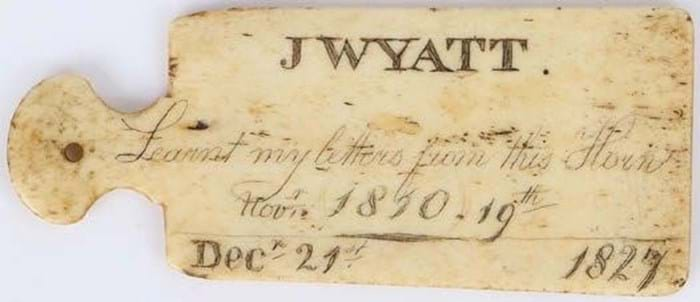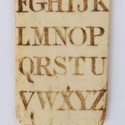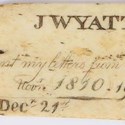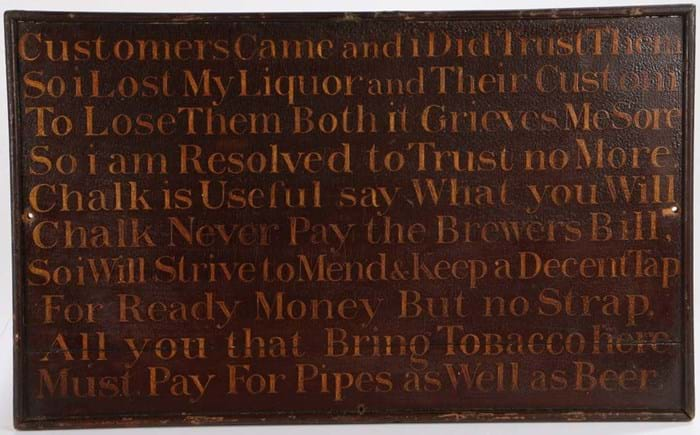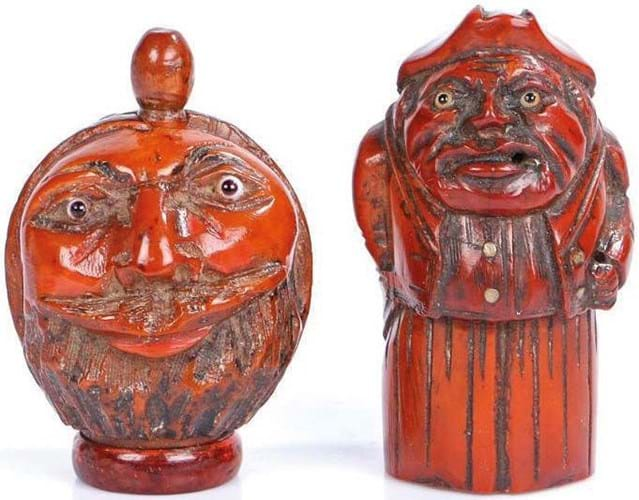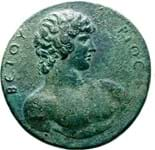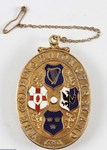Opening with a £7000 Charles II armchair and ending with a £38,000 Henry VIII aumbry, the second of a new series of specialist oak sales at Bishop & Miller (22% buyer’s premium) was confirmation enough for the firm’s founder Oliver Miller that his bet on the most traditional of all antiques will prove a winning format.
Backing his judgment were specialist dealers with the highest of reputations in the trade to maintain: David Houlston, on the rostrum for the sale, and Jack Simonini of Period Oak Antiques.
It was from Period Oak, under its former name The Simoni Collection, that vendors had bought some of the sale stars, adding further assurance to the provenances.
One was the sale-topping c.1520 joined oak aumbry estimated at £20,000-30,000.
The 4ft 8½in (1.44m) tall aumbry comprised three horizontal sections – central foliate carved panels flanked by pierced tracery doors to the top, a middle section with a pair of blind fretwork drawers above a door flanked by a pair of Romayne-type profile bust panels.
Indicative of the aumbry’s high status was not merely the presence of drawers, itself unusual, but the quality of their smooth-running construction.
Pitched at £20,000-30,000, it sold at £38,000.
The 22in (56cm) wide joined oak and inlaid double panel-back open armchair, c.1670, featured bold foliate and cross-hatched carving throughout including, rather unusually, to the uprights.
It was similar to, and almost certainly from the same south-west Yorkshire workshop as, the chair illustrated in Victor Chinnery’s Oak Furniture and the British Tradition that took £17,000 at Bonhams in March 2018.
Not quite in the same bracket, the one at Suffolk sold online just shy of estimate at £7000.
Centuries split
“The current state of the market for 16th century and earlier furniture and works of art has never been stronger, although the 17th century market isn’t doing as well,” says Simonini who, with his wife Jackie, has been specialising in the medieval-17th century period from their base near Penrith for the past 35 years.
Other fomer Period Oak sales to re-emerge at the January 27 Stowmarket auction were a James I oak bed, a Tudor ‘great hall’ enclosed cupboard and a large pair of 14th century limestone gargoyles.
The 6ft 7in tall, 4ft 7in wide (2.01m x 1.4m) West Country bed had a 12-panel tester featuring floral and lozenge carving and a headboard with two panels carved TH 1614. It sold just shy of top-estimate at £11,600.
The c.1500-20 joined oak cupboard featured the familiar three registers: two doors carved with exotic birds above a a pair of doors carved with leaves and heads of beasts supporting a shield centred by a Christogram, and a central panelled cupboard door with pierced and carved panels.
Standing 5ft 6in tall x 4ft 10in wide (1.68 x 1.47m), each side with six linenfold carved panels, it got away just below estimate at £9000.
The c.1320 gargoyles, impressively large at 4ft 7in (1.41m) high, were each carved from a single piece of stone and featured grotesque human faces with gaping mouths; one a kneeling human figure, the other a squatting zoomorphic form with a dog between its knees.
Similar to examples on the Chapter House at York Minster, they took a top-estimate £15,000.
Like most of the auction, all sold to private UK buyers.
Simonini notes that his international clients including Americans are “still strongly buying from us” with the collector base broadening for the medieval furniture and sculpture.
However, Houlston, with 25 years handling Bonhams’ former oak sales behind him and now a member of the BADA, has seen the US market fall away markedly since the highs of a couple of decades ago.
“Oak never suffered the collapse in prices that mahogany furniture did but ordinary pieces such as chests of drawers and dressers did get to a point where the bottom was reached and are now improving,” he said.
“One factor which is appealing to younger buyers, as well as the prices, is the sustainability, the ‘green’ aspect of antique furniture, which is encouraging.”
As far as the US market is concerned, the problem is less changing tastes than the worldwide escalation in shipping costs undermining the base of the pyramid.
“American dealers were a major factor in shipping goods but transport costs have hit the roof, more than tripling in recent years, hitting their chances of making profits back in the States,” said Houlston.
While there was interest from Australia and, to a lesser extent, the Continent, home buyers dominated the 432-lot sale which raised a £258,000 hammer total.
It also featured pieces associated with early vernacular furniture including metalwork and associated works of art. A rare 10in (25cm) long English c.1680-1700 chamberstick doubled expectations at £2400, although fewer than half the 36 brass items sold.
That, and the low take-up on the sale’s folk art section, hit the selling rate which ended up at around 70%.
A to Z guide
There were some notable exceptions, again all going to collectors, including a hornbook and an early 19th century Suffolk wooden pub sign.
The rectangular bone hornbook was engraved with the letters of the alphabet to one side and to the other J Wyatt Learnt my letters from this horn, Nov 1810 19th, Dec 21st 1827. It sold at £1900 against a £300-500 estimate.
The 2ft 1in wide 15in high (63 x 39cm) pub sign, removed by the vendor from The Wild Man at Sproughton in the 1980s, comprised a 12-line verse in fading yellow letters on a red painted background. After recalling a landlord’s woes after allowing credit it warned So i Will Strive to Mend & Keep a Decent Tap, For Ready Money But no Strap.
Estimated at £500-700, this did attract keen US interest but the American underbidder was beaten by an English enthusiast who went to £5200.
Treen was another uneven area of demand and a contributor to the casualty list with the exception of seven 18th century carved figural coquilla nut snuff bottles.
All sold well above estimates, with the top price taken for a pair standing 2in (5.5cm) tall and both with glass eyes, the portly figure with a rucksack and the bearded figure with a bottle plug to the top. They sold online at £2200 against a £400-600 estimate.
The next specialist oak sale takes place in May.


